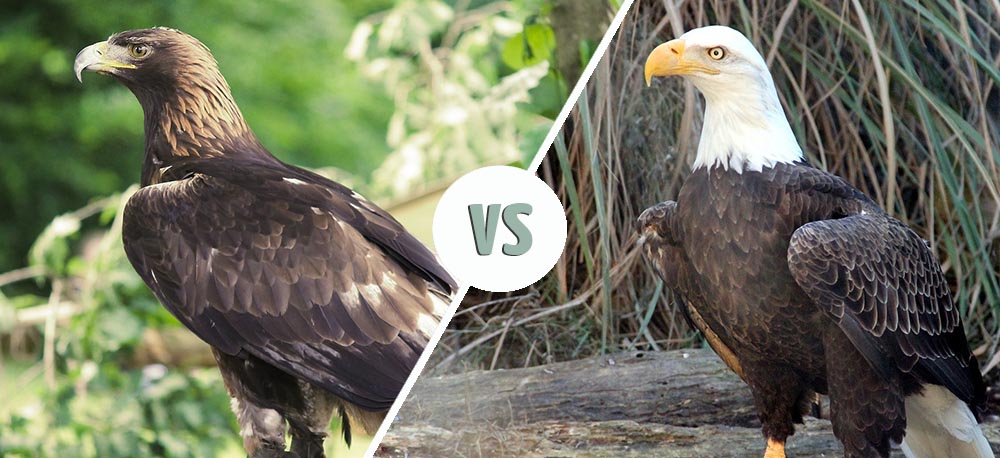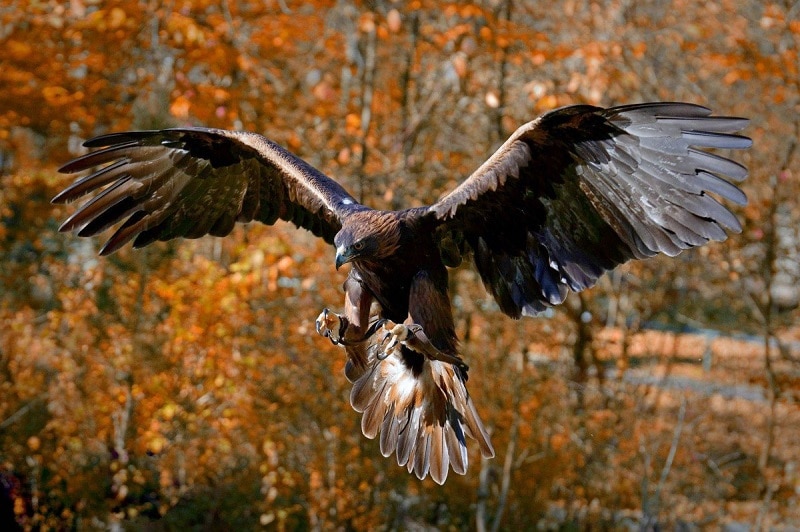Golden Eagle vs. Bald Eagle: The Main Differences
Last Updated on

It’s hard not to notice a Golden Eagle or Bald Eagle flying overhead — both are so big that you could almost mistake them for a plane. They have broad wingspans and a stocky body that adds to the illusion. However, as alike as they may seem, they are different species.
Both species share many traits with the top terrestrial predators on the food chain, which explains their behavior and hunting strategies.
Understanding these raptors better involves delving into their physical, physiological, and behavioral differences. This will provide valuable insight into the vital ecological niche that each bird serves in the ecosystem. The Bald Eagle and Golden Eagle are both worthy of our respect and continuing conservation efforts.

Visual Differences

At a Glance – Golden Eagle vs Bald Eagle
- Average height (adult): 27-33 inches
- Average weight (adult): 106-216 ounces
- Wingspan: 73-87 inches
- Lifespan: Up to 17 years
- Activity pattern: Diurnal
- Trainability: Intelligent but not cautious
- Average height (adult): 28-38 inches
- Average weight (adult): 106-222 ounces
- Wingspan: 80 inches
- Lifespan: Up to 17 years
- Activity pattern: Diurnal
- Trainability: Intelligent yet leery of humans

Golden Eagle Overview
You can think of the Golden Eagle as a symbol of the American West. They are just as much a part of the landscape as the mountains and open rangeland. This raptor is a large bird, one of the biggest of their kind. That makes them a fitting addition to this ecosystem. Their body shape and behavior are precisely adapted to this way of life.
These traits provide a basis for distinguishing the Golden Eagle from the Bald Eagle. Both species are survivors on different playing fields and different playbooks. The fact that they belong to the same family with similar hunting strategies is about the extent of their shared characteristics.

These birds live in different places and habitats. They have varying diets that are riffs on the opportunistic feeding strategy. Both were vulnerable to particular human activities that ultimately has made a profound impact on their continued survival. Perhaps because of their flying range, the Golden Eagle is a rarer sight than the Bald Eagle.
Habitat and Range
The habitat and range of the Golden Eagle reveal stark differences between the two species. This raptor is a fixture in the open country, plains, and mountain foothills. These areas allow the predator to survey their landscape to locate prey with their superior vision. They also provide welcome camouflage that is complemented by the bird’s muted coloration.
The Golden Eagle prefers the habitat and small human population density of the land west of the Mississippi River. They move east during the winter on their migration route. However, their home is the 17 states in the west half of the country. This raptor has all the space they need, with fewer possibilities of disturbance or habitat encroachment.
Behavior
Golden Eagles hunt by soaring overhead, but don’t let their huge wingspan fool you. This bird can maneuver quite well when they must. They are also capable of fast speeds that approach 200 mph on dives. These raptors are even known to play at times: They will fly into the air, carrying small branches or other things in their talons, and then they will drop them and catch them on the way down to the ground.
These birds are well-known for their elaborate courtship displays. A pair will dance in the sky, diving and sailing back and forth. They will mate for life, returning to the same nest each year. They will often take up residence on a cliffside to give themselves and their brood the protection that they need.
Diet
Golden Eagles prefer to eat mammals of all sizes and shapes. They will take whatever they find, sticking primarily to prairie dogs, jackrabbits, and other small animals. Because of their size, they can also bring down the occasional fawn, mountain goat, or swan. They are opportunistic hunters that may even take pets or livestock. These raptors aren’t vocal, though, even in the midst of the chase.

Migration
The Golden Eagle is a year-round resident in the West because of their hardiness. That points to one stark difference between this bird versus the Bald Eagle. The former has feathers all down their legs to help them stay warm. Some birds also overwinter on the East Coast and Canada. Others remain in California or the American southwest.
Golden Eagles make their journey relatively late in the year, in late October to early November. They return to their breeding ranges in mid-April to early May, depending on the weather and prey availability.
Conservation Status
The Golden Eagle is a species of least concern, according to the International Union for Conservation of Nature and Natural Resources (IUCN), as they have a stable population. Their greatest threats are habitat encroachment and wind turbines. While the pesticide DDT affected their numbers, the effect wasn’t as severe because these raptors rarely eat fish. Their population currently numbers about 200,000 birds.
Relationship With Humans
Golden Eagles would have little to do with humans. While they can bring down livestock, they rarely do so. Humans have been a significant part of the bird’s recovery with a falconry practice known as hacking. It involves rearing young eagles to fledgling age in a cage to protect them during this vulnerable period. The birds are released at this point, with continued support from their caretakers until they can hunt on their own.

Bald Eagle Overview
The Bald Eagle goes by many names because of their unique coloration. You may hear them called White-Headed Sea Eagles or even Fish Eagles, referring to their white-feathered head and tail. This coloration takes several years to develop. Until then, it would be easy to mistake a Bald Eagle for an oversized hawk were it not for their yellow beak.

The majesty of this raptor has captured the hearts of many people, including the Native Americans who revere this bird. It is the national symbol of several countries, including Albania, the Czech Republic, and Romania. Interestingly, Benjamin Franklin referred to the Bald Eagle as “a bird of bad moral character. He does not get his living honestly.”
However, it’s hard to deny the raptor’s beauty and toughness. They have endured trying challenges in their life that many species would not survive.
Habitat and Range
The non-breeding range of the Bald Eagle spans the entire lower 48 states. They are a year-round resident along the Pacific Ocean coastline into Alaska and pockets across the country where there is open water. Their preferred habitats are forests, wetlands, and freshwater and marine shorelines. The bird’s breeding range is the north half of the country into Canada.
The Bald Eagle uses mature trees, either coniferous or deciduous, to build their enormous nests that can have diameters of 6 feet or more. The presence of open water is vital to their habitat selection because of this raptor’s diet. They are more tolerant of humans than many other species of their kind, especially when feeding.
Behavior
The Bald Eagle is an intelligent bird that shares many of the same traits as the Golden Eagle. For example, they can also soar quite high into the air.
The Bald Eagle has an impish side too. There have been reports of Bald Eagles stealing food from other predators and even harassing other raptors, such as Ospreys. People have also observed them playing with objects on the ground. The bird has been known to take a dip in the water on occasion.
However, like the Golden Eagle, the Bald Eagle is fiercely territorial and will defend their space from any intruder. This bird also has an elaborate courtship display that is astounding to witness.
Diet
The Bald Eagle’s primary diet is fish. However, they are opportunistic feeders. They will take whatever animals live in the water with the fish, including reptiles, amphibians, and muskrats.

Since they can’t smell, the Bald Eagle has no issue feeding on carrion. Like many predators, the raptor often lives a fast-or-feast lifestyle in between successful hunts.
Migration
The Bald Eagle stays in their non-breeding range as long as there is open water. Otherwise, the bird heads to their wintering ground in early to mid-September. However, some may stay as late as December, until the lakes freeze. While the Bald Eagle lives solitary or in pairs, it will gather with other migrants.
Conservation Status
The Bald Eagle is a species of least concern, according to the IUCN, with an increasing population. The Bald Eagle’s story is a victorious one. One significant contributor was the 1972 ban on DDT by the U.S. Environmental Protection Agency. The IUCN estimates that their population has rebounded 779% in the last 40 years.
Relationship With Humans
The Bald Eagle has a special place in the hearts of Americans. It symbols strength and perseverance. Nonetheless, conflicts exist with wind turbines and bird deaths. Unfortunately, federal law allows a permissible number of bird fatalities. Another concern exists with poaching. While Native Americans can possess feathers and body parts, the birds have overall protection under the Migratory Bird Treaty Act.

Final Thoughts
To see a Golden Eagle or Bald Eagle on the wing is an awe-inspiring experience. Both of these birds fill vital ecological niches in their respective habitats. The world is a better place for the swift conservation measures that saved both these species from the brink of extinction. Hopefully, they will continue to soar to new heights so the next generations can enjoy their beauty and majesty.
You might also be interested in:
- 6 Types of Bird Wings
- Male vs. Female Red-tailed Hawks: Spotting the Differences
- 5 Types of Black Bird Species: Colors and Shapes
Featured Image Credit: (L) Manfred Richter, Pixabay | (R) steve felberg, Pixabay
About the Author Robert Sparks
Robert’s obsession with all things optical started early in life, when his optician father would bring home prototypes for Robert to play with. Nowadays, Robert is dedicated to helping others find the right optics for their needs. His hobbies include astronomy, astrophysics, and model building. Originally from Newark, NJ, he resides in Santa Fe, New Mexico, where the nighttime skies are filled with glittering stars.
Related Articles:
How to Clean a Refractor Telescope: Step-by-Step Guide
How to Clean a Telescope Eyepiece: Step-by-Step Guide
How to Clean a Rifle Scope: 8 Expert Tips
Monocular vs Telescope: Differences Explained (With Pictures)
What Is a Monocular Used For? 8 Common Functions
How to Clean a Telescope Mirror: 8 Expert Tips
Brightfield vs Phase Contrast Microscopy: The Differences Explained
SkyCamHD Drone Review: Pros, Cons, FAQ, & Verdict
